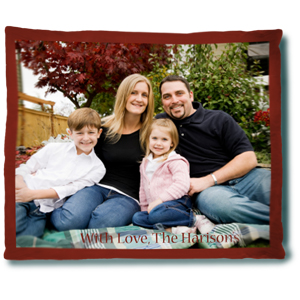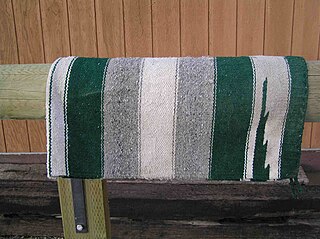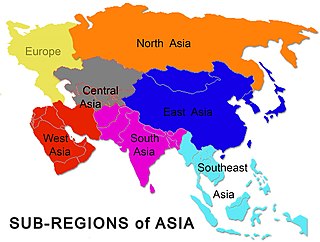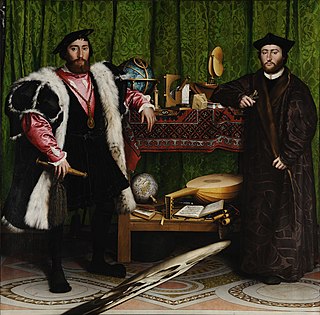
Knitting is a method by which yarn is manipulated to create a textile or fabric, often used in many types of garments.

A textile is a flexible material consisting of a network of natural or artificial fibers. Yarn is produced by spinning raw fibres of wool, flax, cotton, hemp, or other materials to produce long strands. Textiles are formed by weaving, knitting, crocheting, knotting or tatting, felting, or braiding.

Textile arts are arts and crafts that use plant, animal, or synthetic fibers to construct practical or decorative objects.
Ikat is a dyeing technique used to pattern textiles that employs resist dyeing on the yarns prior to dyeing and weaving the fabric.
Flannel is a soft woven fabric, of various fineness. Flannel was originally made from carded wool or worsted yarn, but is now often made from either wool, cotton, or synthetic fiber. Vegetable flannel is made from Scots pine fibre.

Dyeing is the application of dyes or pigments on textile materials such as fibers, yarns, and fabrics with the objective of achieving color with desired fastness. Dyeing is normally done in a special solution containing dyes and particular chemical material. Dye molecules are fixed to the fibre by absorption, diffusion, or bonding with temperature and time being key controlling factors. The bond between dye molecule and fibre may be strong or weak, depending on the dye used. Dyeing and printing are different applications; in printing color is applied to a localized area with desired patterns and in dyeing it is applied to the entire textile.
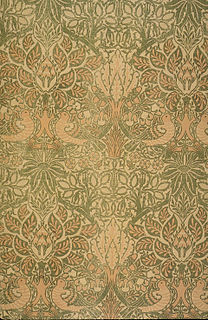
Double cloth or double weave is a kind of woven textile in which two or more sets of warps and one or more sets of weft or filling yarns are interconnected to form a two-layered cloth. The movement of threads between the layers allows complex patterns and surface textures to be created.

Paithani is a variety of sari, named after the Paithan town in Aurangabad Maharashtra state where they are woven by hand. Made from very fine silk, it is considered as one of the richest saris in India. It is one of the most famous saris in India.It is also considered the finest silk in India.

Kasuri (絣) is a Japanese word for fabric that has been woven with fibers dyed specifically to create patterns and images in the fabric. It is an ikat (resist-dyeing) technique. The patterns are characterized by a blurred or brushed appearance. The warp and weft threads are resist-dyed in specific patterns. Prior to dyeing, sections of the warp and weft yarns are tightly wrapped with thread to protect them from the dye. When woven together, the undyed areas interlace to form patterns. Many variations are possible. Kasuri patterns may be applied to the warp or to the weft; or to both the warp and the weft. There are many techniques used to create kasuri. The cloth is classified with different names depending on the method used.
Knitted fabric is a textile that results from knitting. Its properties are distinct from woven fabric in that it is more flexible and can be more readily constructed into smaller pieces, making it ideal for socks and hats.
The manufacture of textiles is one of the oldest of human technologies. To make textiles, the first requirement is a source of fibre from which a yarn can be made, primarily by spinning. The yarn is processed by knitting or weaving, which turns yarn into cloth. The machine used for weaving is the loom. For decoration, the process of colouring yarn or the finished material is dyeing. For more information of the various steps, see textile manufacturing.
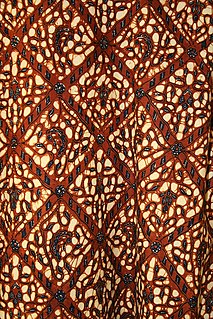
Resist dyeing (resist-dyeing) is a traditional method of dyeing textiles with patterns. Methods are used to "resist" or prevent the dye from reaching all the cloth, thereby creating a pattern and ground. The most common forms use wax, some type of paste made from starch or mud, or a mechanical resist that manipulates the cloth such as tying or stitching. Another form of resist involves using a chemical agent in a specific type of dye that will repel another type of dye printed over the top. The best-known varieties today include tie-dye and batik.

The Andean textile tradition once spanned from the Pre-Columbian to the Colonial era throughout the western coast of South America, but was mainly concentrated in Peru. The arid desert conditions along the coast of Peru have allowed for the preservation of these dyed textiles, which can date to 6000 years old. Many of the surviving textile samples were from funerary bundles, however, these textiles also encompassed a variety of functions. These functions included the use of woven textiles for ceremonial clothing or cloth armor as well as knotted fibers for record-keeping. The textile arts were instrumental in political negotiations, and were used as diplomatic tools that were exchanged between groups. Textiles were also used to communicate wealth, social status, and regional affiliation with others. The cultural emphasis on the textile arts was often based on the believed spiritual and metaphysical qualities of the origins of materials used, as well as cosmological and symbolic messages within the visual appearance of the textiles. Traditionally, the thread used for textiles was spun from indigenous cotton plants, as well as alpaca and llama wool.

In textile manufacturing, finishing refers to the processes that convert the woven or knitted cloth into a usable material and more specifically to any process performed after dyeing the yarn or fabric to improve the look, performance, or "hand" (feel) of the finish textile or clothing. The precise meaning depends on context.
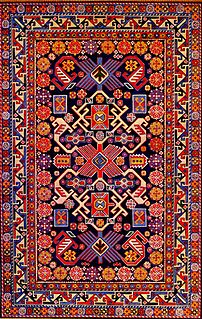
Azerbaijani rugs are a product of Azerbaijan, an ancient center of carpet weaving. The Azerbaijani rug is a traditional handmade textile of various sizes, with dense texture and a pile or pile-less surface, whose patterns are characteristic of Azerbaijan's many carpet-making regions. Traditionally, since ancient times the carpets were used in Azerbaijan to cover floors, decorate interior walls, sofas, chairs, beds and tables.
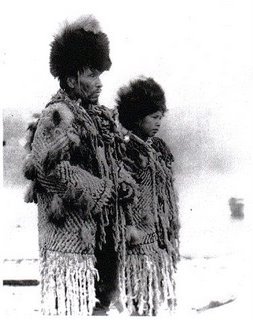
The Salish are skilled weavers of the Pacific Northwest. They are most noted for their beautiful twill blankets many of which are very old. The adoption of new fabrics, dyes, and weaving techniques allow us to study a wide variety of Salish weavings today.

The national costume of Indonesia is the national costume that represents the Republic of Indonesia. It is derived from Indonesian culture and Indonesian traditional textile traditions. Today the most widely recognized Indonesian national costumes include batik and kebaya, although originally those costumes mainly belong within the culture of Java and Bali, most prominently within Javanese, Sundanese and Balinese culture. Since Java has been the political and population center of Indonesia, folk costume from the island has become elevated into national status.

Odisha Ikat is a kind of ikat, a resist dyeing technique, originating from Indian state of Odisha. Also known as "Bandha of Odisha", it is a geographically tagged product of Odisha since 2007. It is made through a process of tie-dying the warp and weft threads to create the design on the loom prior to weaving. It is unlike any other ikat woven in the rest of the country because of its design process, which has been called "poetry on the loom". This design is in vogue only at the western and eastern regions of Odisha; similar designs are produced by community groups called the Bhulia, Kostha Asani, and Patara. The fabric gives a striking curvilinear appearance. Saris made out of this fabric feature bands of brocade in the borders and also at the ends, called anchal or pallu. Its forms are purposefully feathered, giving the edges a "hazy and fragile" appearance. Ikat's equivalent usage in Malay language is mengikat, which means "to tie or to bind".
Kotpad Handloom is a vegetable-dyed fabric woven by the tribal weavers of the Mirgan community of Kotpad village in Koraput district, Odisha, India. Cotton sarees with solid border and Pata Anchal, duppatta with typical Buties / motifs, Scolrfs on cotton, silk, handloom stoles, and dress materials are all dyed with organic dyes. The natural dye is manufactured from the aul tree grown in this area. The Kotpad tussar silk saree with tribal art and Kotpad handloom fabrics with natural color is its specialty.
Bruneian art is art from the country of Brunei. Brunei's art includes paintings, jewelry, and clothing.
